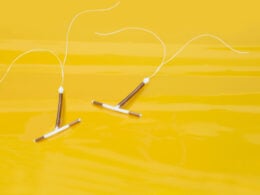“Are you and your husband thinking about having more?” my well-meaning midwife recently asked me at my 6-week postpartum check-up.
“Yes, definitely, in a little while,” was my immediate answer. Despite now having the so-called “perfect” American family of one little boy and one (newborn) little girl, my husband and I do hope to have more children down the line.
“Okay, I know you use Natural Family Planning,” my midwife continued, “and that will work okay since you want more kids. But if you had just had, say, your fifth baby, we might want to be discussing something a bit more permanent.”
Given that my midwife and I have a good rapport, and that she has always been kind and respectful of my wishes throughout my recent pregnancy and delivery, I simply let this last comment slide.
But maybe I shouldn’t have.
Post-tubal ligation syndrome and heavy, painful, or irregular periods
A recent article from TODAY examined the growing phenomenon of post-tubal ligation syndrome, the darker side of tubal ligations—no doubt the “more permanent solution” my midwife was hinting at—a procedure which many women turn to when they and their partners decide they are done having kids.
For many women, tubal ligations seem like the natural choice when they’re done growing their family—after all, why would you want to bother with the Pill or an IUD if you know you’re done? But some women who’ve had the procedure are now experiencing a whole range of unsavory side effects that they claim they were never warned about beforehand. Enough women are experiencing this phenomenon that it has a name: post-tubal ligation syndrome.
The women interviewed by TODAY detailed concerning symptoms like painful, heavy periods, chills, migraines, depression, and nausea. Yet many struggle to find help from their doctors, because post-tubal ligation syndrome is not well understood. At the time this article first published in 2019, no studies had yet been done to examine the symptoms of post-tubal ligation syndrome. One doctor interviewed by the TODAY article noted that some of these symptoms could be due to underlying issues that were once masked by birth control.
Studies now confirm the experiences of women with PTLS
Since 2019, however, a few studies have found evidence to support the experiences of women suffering from PTLS. One study of 60 women in Pakistan found that “Menorrhagia occurred more frequently in women with tubal ligation than in women without tubal ligation” [1]. Menorrhagia is the clinical term used to describe heavy periods. Another larger study of 220 women, found that women who underwent tubal ligation during a cesarean section had more menstrual cycle irregularity, when compared to women who underwent caesarean sections but did not have a tubal ligation [2].
As of April 2021, WebMD has also realized the existence of PTLS, listing potential symptoms such as pain (including pelvic pain, pain during sex, lower back pain, and headaches), period changes (such as painful periods, bleeding or spotting between periods, or cessation of periods), PMS-like symptoms (such as acne, tender breasts, bloating, fatigue, and food cravings), menopause-like symptoms (such as hot flashes, insomnia, night sweats, changes in libido, and brain fog), and mood changes/symptoms (such as mood swings, depression, anxiety, or crying).
Setting aside the mounting evidence of post-tubal ligation syndrome, the long-term complication most commonly experienced after a woman has her tubes tied is regret. In fact, rates of regret as high as 26% have been reported by women who have had the procedure [3]. (And, interestingly, one study showed comparable rates of regret for women who regret their partner’s vasectomies with rates of regret for women who’ve had their own sterilization procedures.) Reversals may sometimes be possible, but not in all cases.
You don’t need a “permanent solution” to effectively prevent pregnancy without birth control
Given all of this information about tubal ligations and the possibility of post-tubal ligation syndrome, I wish more people—my midwife included —understood the truth about Natural Family Planning (NFP) and Fertility Awareness Methods (FAMs). I wish they know how effective these methods are, even after a couple has decided they are done having kids, and that they don’t carry the potential for dangerous symptoms or permanent regret.
In the 5+ years since my husband and I have been using NFP to plan our family, we have used it to fit whatever our particular family planning needs. From using it to postpone pregnancy as newlyweds and postpartum, to using it (in conjunction with NaProTechnology) to diagnose and treat infertility and conceive our two children, Natural Family Planning has worked very well for us. I see little reason why that should change when my husband and I discern that our family is complete. As physician assistant Allison Jung shared with Natural Womanhood, Natural Family Planning methods can be as effective at preventing pregnancy as more permanent birth control methods—and even better, they take into account the holistic picture of a women’s health goals.
References:
[1] Ujala S, Masood A, Shaheen N. Comparison Of The Frequency Of Menorrhagia In Post-Tubal Ligation Women Versus Normal (Non-Tubal Ligation) Women. Rawal Medical Journal, Vol 45 (4); 2020:822-825. https://www.rmj.org.pk/fulltext/27-1586104288.pdf [2] 2. Taşkömür A, Erten Ö. The effect of tubal ligation surgery during cesarean operation on dysmenorrhoea, dyspareunia and menstrual cycle. J Gynecol Obstet Hum Reprod. 2021;50(6):102054. doi:10.1016/j.jogoh.2020.102054. Available at: https://www.sciencedirect.com/science/article/abs/pii/S246878472030430X [3] Bartz D, Greenberg J. Sterilization in the United States. Rev Obstet Gynecol. 2008;Winter(1):23-32. https://www.ncbi.nlm.nih.gov/pmc/articles/PMC2492586/. Accessed August 23, 2021.bi.nlm.nih.gov/pmc/articles/PMC2492586/Additional Reading:
Done with kids: thinking of sterilization?
The Unethical Push to Sterilize Women in the Delivery Room
Bayer finally pays for Essure damages, but women’s injuries still go ignored
This article was originally published as written by Grace Emily Stark on August 20, 2019. It has since been updated by Natural Womanhood to offer more information.
Last updated August 23, 2021.











